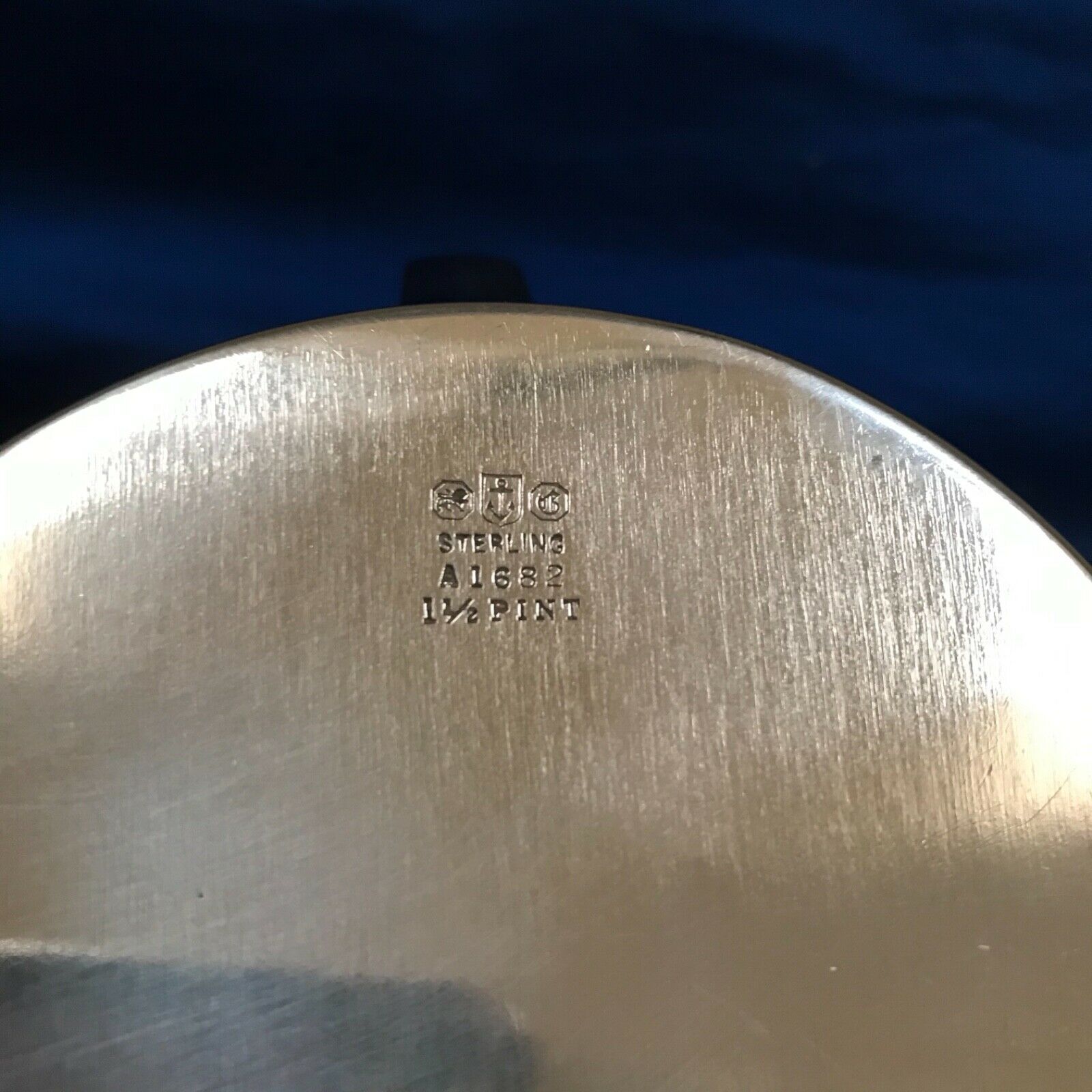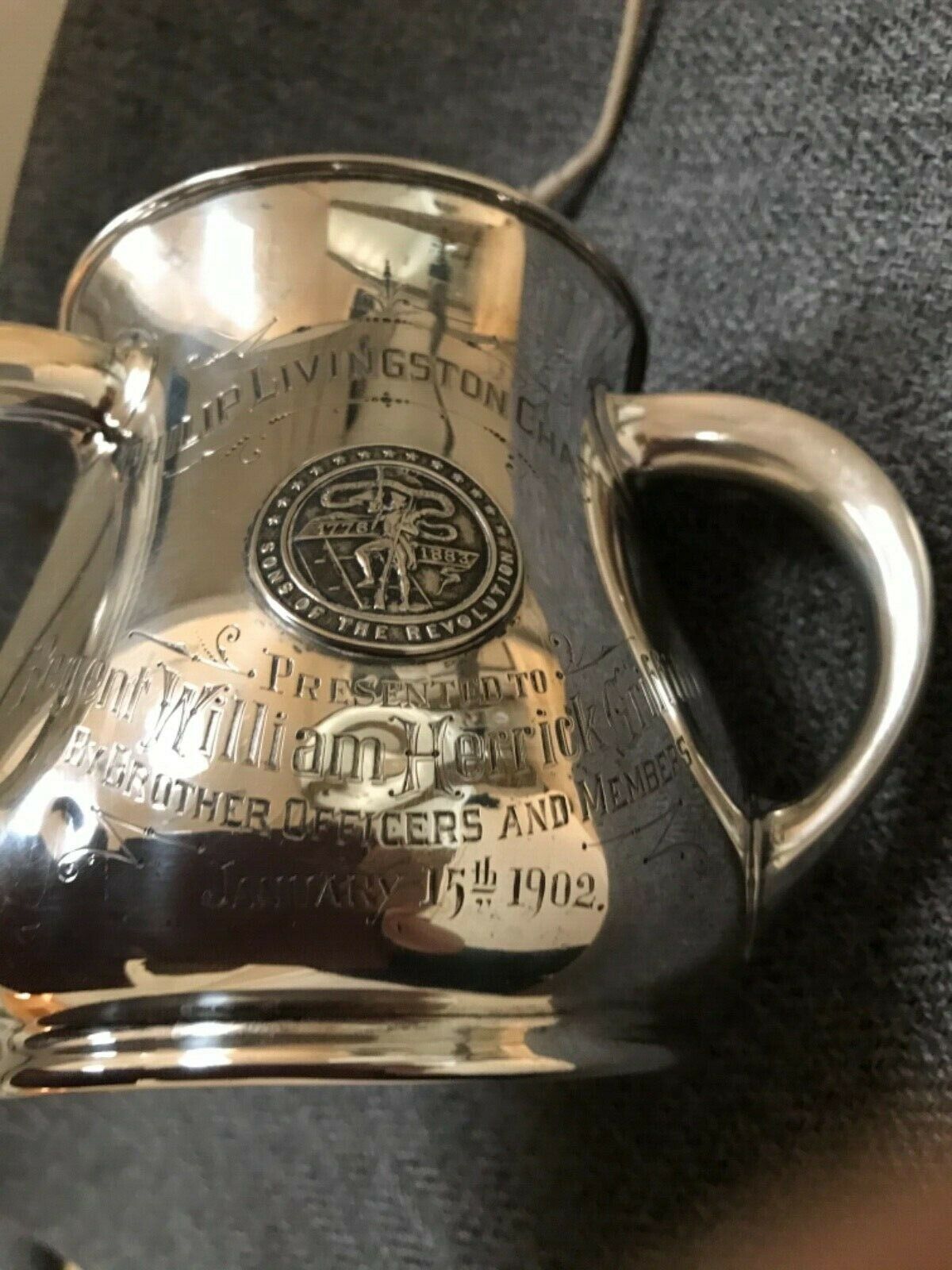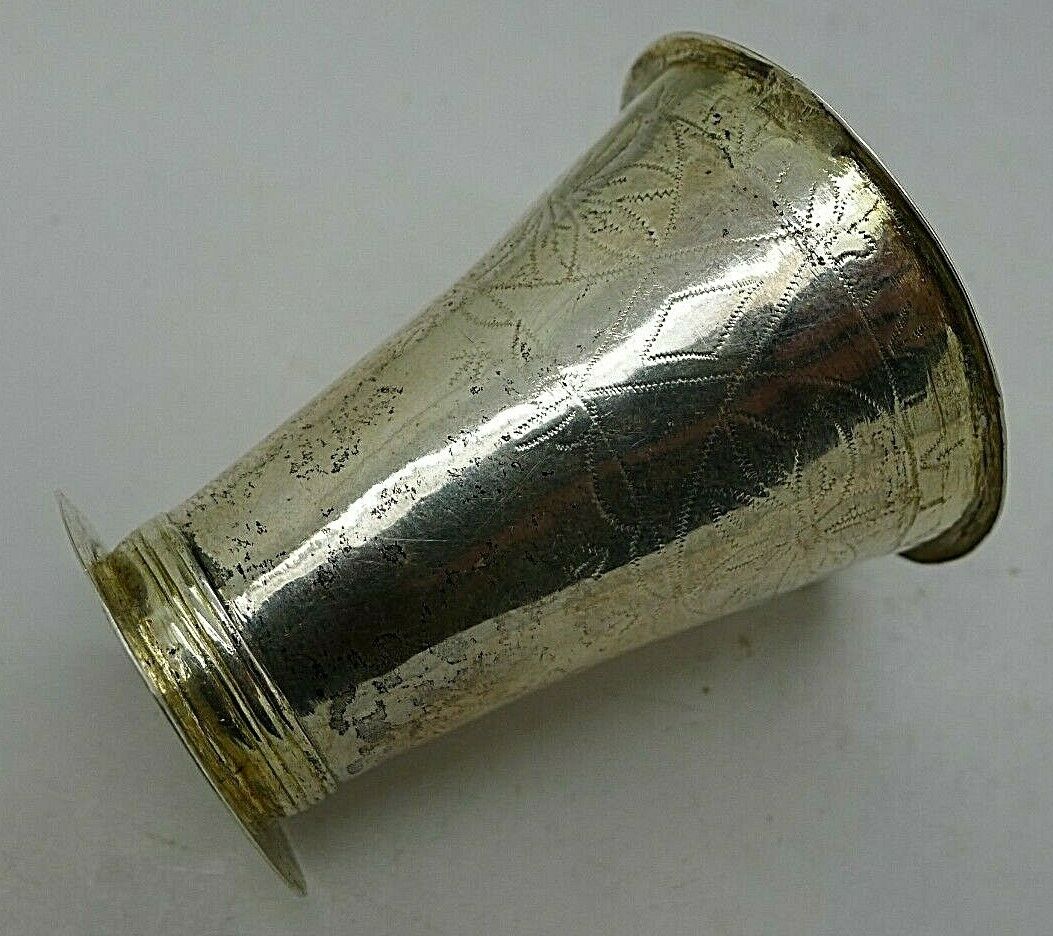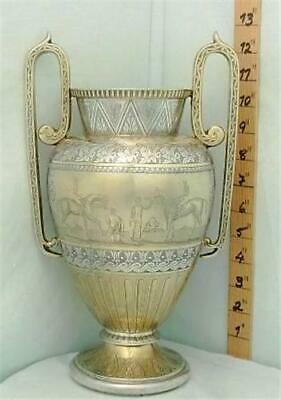-40%
Antique c1900 GORHAM STERLING SILVER 3 HANDLE LOVING CUP trophy HAND ENGRAVED
$ 157.87
- Description
- Size Guide
Description
A fascinating piece with provenance - American history specificGorgeous solid sterling silver 3 handle loving cup
Full Gorham (Providence, RI) hallmarks
The cup dates c.1895-1900
4 1/2” tall , 4 1/4” wide body handles extend 2 1/2” from body of cup
weighs 10.33 ounces
beautiful solid sterling silver with one easy to repair as desired dent on the back (pictured) and two pin prick dents under engraving on the front
- these do not detract from the overall beauty of this fabulous antique historic silver piece
It was beautifully and intricately hand chased and hand engraved by a master craftsman c.1902 for presentation to
Regent William Herrick for his valuable service to the
Sons of the Revolution
(V) William Herrick
, son of Edwin Henry and Mary Louisa (Knowlton) Griffith, was born at Castleton, Rensselaer county, New York, January 27, 1866, named for Sir William Herrick. of London, Leicester and Beau Manor Park, from whom he is ninth in lineal descent. On his father's side he is lineally descended from the New England and Colonial families of Herrick, Paine, Smith, Perrin, Trask, Leonard, Avery, Denison, Stanton, Starkweather, Lord, Thompson, Peck, Chickering, Cross, Lay, and the Platts and Scudders of Long Island. Of these the Paines, Perrins, Herricks, Averys, Denisons, Stantons, Lords, Pecks and Platts were entitled to and made use of coats-of-arms. Mr. Griffith received his primary education at "Jane Coley's Private School for Boys" at Albany. He was partly prepared for college at the Albany Academy and advanced by the private tuition of Rev. Charles H. W. Stocking, D.D. He entered Yale in 1886, but ill health prevented completion of the course, and he then traveled with Dr. Stocking through England, Scotland, Germany, Holland, Belgium, Austria, France, Italy and Switzerland, makig his sojourn in these countries an educational one, to a great extent, and studying the archaeology, life and customs of the various places, which brought about his contributions to various American periodicals while he was abroad.
On returning from Europe, Mr. Griffith accepted a position in the First National Bank of Albany, and after some years resigned to embark for himself in the insurance business, his offices in 1910 being in the Tweddle Building, Albany, New York, and his residence No. 445 State street. He was probably the first to attempt organizing the members of his family on the maternal side into the Knowlton Association of America. This was due to the fondness he had always had for all matters appertaining to genealogy, history and patriotic hereditary orders, and it was natural that he was chosen its secretary and treasurer. He possesses many heirlooms and relics, chief among which he prizes the musket carried by his great-great-grandfather, Lieutenant Daniel Knowlton, while a private and sergeant in the old French war; some Revolutionary scrip with which he was paid off, and a few of his old books. Credit is due to him for his activity in the interest of Philip Livingston Chapter, Sons of the Revolution, of which he was treasurer in 1896, secretary in 1897-98, vice-regent in 1899 and regent in 1900-01.
Mr. Griffith can count twenty-five ancestors who performed illustrious military and civil services in the colonies previous to 1775; six ancestors who were officers in the continental army during the revolution, and two who rendered service in the war of 1812. This unusually favorable condition renders him eligible to nearly all of the patriotic hereditary orders, and he has joined nearly every one. He holds membership in the "Sons of the Revolution" in right of services of and lineal descent from: Colonel Rufus Herrick, Major Robert Freeman, Captain Israel Platt, Lieutenant Daniel Knowlton, William and Joshua Griffith, Ensign William Peters, Privates Nicholas and Garrett Row. In the "Society of Colonial Wars" he represents: Governor Robert Treat, Hon. Richard Treat, Stephen Hopkins of the "Mayflower"; eight in King Philip's war, General Constant Southworth, Captain George Denison, Captain John Denison, Major Epenetus Platt, Captain James Avery, Captain John Stanton, Captain Edward Bangs, Deacon John Doane, Sergeant Daniel Knowlton, Stephen Paine, Thomas Stanton, Nicholas Snow, Samuel Mayo, William Lumpkin, William Collier, Joseph Ford, Bozoan Allen, John Pinder, Samuel Leonard and Stephen Herrick. In the "Society of Mayflower Descendants" he represents: Stephen Hopkins. In the "Order of Founders and Patriots" he represents: John Knowlton (1639) and Lieutenant Daniel Knowlton (1738-1825). In the "Society of War of 1812," he represents: Major Joshua Griffith. In the "Order of the Old Guard of Illinois" he represents Colonel Rufus Herrick, Captain George Denison and Major Joshua Griffith. He was chosen registrar-general and genealogist of the "Ancient Heraldic and Chivalric Order of Albion," founded by Sir Edmund Plowden in 1640, and holds membership in the New England Historical Genealogical Society, Baronial Order of Runnymede, Order of Colonial Governors, the New York State Historical Association, Old Northwest Genealogical Society, and is a thirty-second degree Mason, being a member of Masters Lodge, No. 5, Free and Accepted Masons, and of Albany Sovereign Consistory,
Ancient and Accepted Scottish Rite
. While residing from 1892 until 1907 at 989 Madison Avenue, was a vestryman of St. Andrew's Episcopal Church, Pine Hills, and was also lay reader of the parish. He is now a member of the Episcopal Cathedral of All Saints at Albany. In politics he is a Republican.
William H. Griffith married, in St. Paul's Church, Albany, February 3, 1892, by Rev. J. S. B. Hodges, S.T.D., of Baltimore, and Rev. C. H. W. Stocking, D.D., of Orange, New Jersey, Grace Elizabeth Clute, daughter of Hon. Matthew Henry and Elizabeth (Clute) Robertson, who were married at St. George's Church, Schenectady, June 2, 1863. Child, Margaret Frances, born at Albany, New York, December 27, 1892.
Grace Elizabeth Clute (Robertson) Griffith was born in Albany, New York, and was baptized in St. George's Episcopal Church of Schenectady. She was educated at St. Agnes' School, Albany, graduating in 1883, as Latin salutatorian of her class. She was elected regent of Gansevoort Chapter, Daughters of the American Revolution, and president of the Society of Graduates of St. Agnes' School. She has been a member of the National Mary Washington Colonial Association since her mother's death.
Matthew Henry Robertson, father of Mrs. William H. Griffith, was born at Malmesbury, Wiltshire, England, died at Albany, December 19, 1903. He studied law at the place of his birth, and in 1858 came to Albany, where he continued his studies in the office of Hon. William Barnes, continuing thus until January, 1860, when the New York State Insurance Department being organized, and Mr. Barnes receiving the appointment of its first superintendent, on May 1, 1860, Mr. Robertson became a regular clerk in the department; in 1870 became the chief clerk, continuing as such until in June, 1892, Superintendent James F. Pierce appointed him the second deputy, which position he held until his death. He was a vestryman of St. Paul's Church for fourteen years. He was the son of James Robertson, born at Malmesbury, England, August 12, 1802, died March 16, 1876, at Chicago, Illinois, and his wife, Elizabeth Worcester, born October 25, 1804, at Coventry, England, died at Malmesbury, England, March 15, 1841, whom he married April 6, 1826. Elizabeth Worcester was the daughter of Charles Worcester, born at Coventry, England, November 1, 1773, who married, June 5, 1802, Elizabeth Newcomb, born November 25, 1782, at Coventry, England; son of Joseph Worcester, born December 7, 1739; married, January 3, 1764, Susannah Holmes, born 1742; son of John Worcester, died April 14, 1763; married, May 28, 1738, Mary Smith, died May 12, 1763; son of Joseph Worcester. Matthew H. Robertson's grandfather was Matthew Robertson, of Monditts Park, Malmesbury, England, born in 1756, died August 21, 1825; married Ann Beams, born at Chippenham, England, in 1765, died at Malmesbury, in 1839. He was of Scottish descent, from Alexander Robertson, of Strowan, distinguished as a poet and partisan of the Stewarts in the uprisings of 1690, 1715, and 1745. This was one of the oldest and most distinguished families of Scotland, being the sole remaining branch of the Royal House which occupied the throne of Scotland during the eleventh, twelfth, and thirteenth centuries.
Elizabeth (Clute) Robertson, mother of Mrs. William H. Griffith, was born at Schenectady, New York. She resided for many years at her home, No. 445 State street, Albany, New York, and died there August 1, 1906. She was a member of Mohawk Chapter, Daughters of the American Revolution, and of National Mary Washington Colonial Association. She traces her descent from Frederick Clute, who came to this country from Neurenbergh as a trader, and after living a time at Kingston, New York in 1703, bought land of Johannes Clute at Niskayuna, New York. He married Francyntje Du Mont (Dumond) and they had son, Jacob, born at Kingston, November 6, 1698, who married, November 16, 1727, at Albany, Maria Brouwer, baptized May 1, 1709, at Brooklyn, through her heirs to the Anneke Jans estate and descent from William I. of Holland. Jacob Clute and Maria Brouwer had a son, Pieter Clute, born at Albany, died at Schenectady, 1780; married Catherine Marselis, born February 15, 1736, died at Niskayuna, aged eighty-one years. They had a son, Peter Clute, born at Schenectady, April 28, 1765, died there July 7, 1835; married, March 5, 1786, Angelica Van Slyke, born, Schenectady, September 2, 1764, died there May 24, 1848, being the daughter of Cornelius Van Slyke, born, Schenectady, December 1, 1736, who was first lieutenant in Colonel Goose Van Schaick's regiment, New York State Continental line in the revolution, and Catherine Veeder, born, Schenectady, April 22, 1744. Peter Clute and Angelica Van Slyke had a son, Cornelius Peter Clute, born at Schenectady, November 14, 1788, died there, August 30, 1870; married, Schenectady, April 16, 1828, Angelica Truax, born February 13, 1796, at Schenectady, died there October 4, 1878, being the daughter of Isaac Truax, born at Schenectady, July 19, 1755, died there December 22, 1854; married, January 1, 1794, Elizabeth Clute, born, Albany, August 21, 1757, died Schenectady, August 4, 1847. Cornelius P. Clute and Angelica Truax had a daughter, Elizabeth Clute, who married Hon. Matthew Henry Robertson.
(The Knowlton Line)
The family name of Knowlton is derived from the Cornish-British word, "knowl," a promontory, hill or eminence, with the suffix "ton," or the old Saxon "tun," for town, and signifies people "from the hill town." The place where the Knowltons lived was long known as Knowhill. In the Domesday Book the name is Chenoltone, and in subsequent books it may be found indifferently spelled Cnolton, Knolton, Knollton, Knowlton, Knoulton, Knowton, Knowlden, Nowton, Noulton and Nolton.
Going back to the Middle Ages, one learns of the tradition of two brothers enlisting in the service of William the Conqueror, and fighting so bravely during his invasion of Wales, that they readily won their spurs. Having observed that they resided, the one on a hill and the other on a knoll, or lesser hill, the king, on investing them with the honors and insignia of knighthood, dubbed them Hill-ton and Knoll-ton. Whatever of truth may attach to this tradition, it is certain that the name is an ancient one, born out of its own native soil. The Knowlton Arms — certified by H. Farnham Burke, Somerset Herald. Shield: Argent, a chevron between three crowns or ducal coronets sable. Crest: A demi-lion rampant. Motto:
Vi et virtute
.
Regarding where they lived, in the Domesday Book, that curious and quaint record of estates and surveys which the Conquerer ordered in 1083, that he might know the extent of his realm and provide for the royal revenues, there was a Knowlton Hundred, which was originally but a mere hamlet in Dorsetshire, which became by royal appointment a Fair Town and a rural center of considerable importance. The original hamlet and manor have long since passed away; but the name survives. Knowlton Parish and Knowlton Hall still designate a manor and baronial residence in Kent county, six miles from the archepiscopal city of Canterbury.
Thomas Knowlton, the antiquarian, was fond of telling of the distinction enjoyed by one of his ancestors, a retainer of the Earl of Warwick, who always appeared in court dress, with a silver and jewelled sword at his belt, and other insignias of rank, and who stood high with the king. He had charge of one of the Earl's castles in Kent, and was a descendant of the Knowltons mentioned.
(I) Captain William Knowlton
, the progenitor of the family in America, sailed from the Port of London for Nova Scotia in 1632-34, as is usually believed, although this date only approximate. It is probable that his sons John, William, Deacon Thomas, and perhaps Samuel, accompanied him on the voyage, for one of the latter name was found in Hingham soon after the others appeared in Ipswich, and he died in 1655, leaving a will, probated September, 1655, in which he names "brother John" as executor. Captain Knowlton died on the westward voyage, and his widow and children proceeded to Nova Scotia, where they remained only a short time. They are next heard of as being in Ipswich, Massachusetts, where his son John became a resident in 1639, William and Thomas following him there in 1642. The old town had been organized only the previous year, when John arrived. Captain Knowlton was at least a part owner of the vessel in which he sailed for America, and his death doubtless occurred not far from Nova Scotia, for a land surveyor, Alphonso Wells, employed by the Canadian government to survey land in Shelburne in 1839, found an ancient headstone there bearing the name of William Knowlton, 1632. It is tradition that the vessel was sold there, near Annapolis the first settlement, and with the proceeds his widow and children went to Hingham the following year, where it is believed that she remarried.
Patriotic devotion to their new country was a marked feature of these early settlers, and the Knowltons were no exception. Four of the name, John, Benjamin, Abraham and William, served in King Philip's war; several of them participated in the siege and capture of Louisburg; the rosters of the revolutionary troops frequently bear the Knowlton name, and in the subsequent wars of 1812 and of the revolution the same stock was notably at the front. Old Ipswich gave an extraordinary proof of this devotion to country on June 9, 1788, when all the commoners, including many Knowltons, surrendered all their lands to pay the town debts incurred during the war of independence. Family history gives the name of Ann Elizabeth Smith as the wife who came to this country with Captain William Knowlton, and on June 9, 1668, the records show that one Ann, widow of William Knollton, petitioned for an appraisal of land in Hingham. Children:
John, born 1610, see forward;
William, born 1615, married Elizabeth ————;
Deacon Thomas, born 1622, married (first) Susannah ————; (second) Mary Kimball;
Samuel.

















